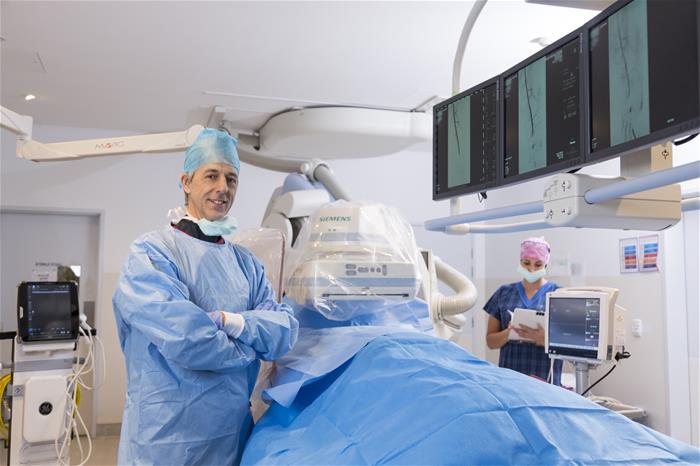Living longer with internal radiation

Patients with liver tumours may live longer with a minimally invasive internal radiation therapy treatment that destroys the tumours.
Selective Internal Radiation Therapy (SIRT) involves injecting millions of tiny radioactive microspheres into the bloodstream directly to liver tumours. They are then trapped in small blood vessels and cause radiation damage to the tumours.
Wesley Medical Imaging interventional radiologist Dr Duncan Walker (pictured) said the treatment can stop progression of the tumour.
“The liver is an important organ in terms of cancer,” Dr Walker said.
“When the disease gets into the liver it often is the cause of death. Delaying progress in the liver means patients live longer. SIRT is a tool that has proven survival benefit when used as a part of wider cancer treatment.”
For patients, the treatment can mean a six month break from systemic chemotherapy treatment. SIRT is a one-off procedure, with side-effects of nausea and tiredness lasting only two to three weeks. Compared to the intensive chemotherapy and external radiation schedule and side-effects some patients endure, it can seem like a breath of fresh air.
“The treatment is useful both on its own, in combination with chemotherapy, and as a way to give patients a break from chemo,” Dr Walker said.
“Systemic chemo is hard graft with frequent treatment cycles, and this gives them a chance to recover.”
SIRT could be used as the first, second, or even third line of treatment. It was a technique that was applicable to a wide range of liver cancers, Dr Walker said.
“There are very few liver cancers that don’t respond to this treatment. It doesn’t really matter whether it’s metastatic or primary liver cancer – most tumours in the liver will respond to this.”
Dr Walker said this relatively new technique had not been subjected to extensive long-term research. However, a worldwide study called SIRFLOX, which is designed to evaluate SIRT as an initial treatment option for patients with colorectal cancer that has spread to the liver, has found SIRT treatment delayed disease progression in the liver with overall survival data awaited in 2017.
The Wesley is one of the few hospitals – public or private – to provide this treatment option. Doctors at the Wesley have performed more than 660 SIRT procedures over the past 15 years, working with oncologists from Queensland, Northern New South Wales and New Zealand.
SIRT – The process:
+Two weeks before treatment:
An initial consultation with an interventional radiologist
+A week before treatment: An angiogram is performed to map the blood vessels in the liver and to test treatment uptake in tumour. This is a day surgery procedure.
+Day of treatment: Radioactive microspheres are inserted into a catheter and travel to the liver, where they lodge in blood vessels in the liver tumours. Beta radiation destroys cells in a 3mm radius around the microsphere. Patient discharged after an overnight stay in hospital.














